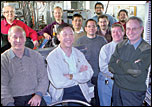Next-Generation Light Source Development Focused on Deep Ultraviolet Free-Electron Laser
Despite the myriad of discoveries using the super bright
beams provided by the National Synchrotron Light Source at Brookhaven Lab
and other light sources around the world, researchers who use synchrotron
light would always welcome even more brilliant and revealing beams.
Toward this end, NSLS accelerator physicists and other staff are
developing a novel combination of a synchrotron and a laser: the world’s
only free-electron laser that produces intense deep ultraviolet light
through a process called high-gain harmonic generation.
When the DUV-FEL is complete, it will present many new scientific
opportunities for its users in the fields of chemistry, condensed-matter
physics, geology, materials science, and more.
by Patrice Pages and Marsha Belford
Because super bright beams of x-ray, ultraviolet, and infrared light are produced at the National Synchrotron Light Source (NSLS) at Brookhaven Lab, more than 2,500 guest researchers from nearly 500 universities, laboratories, and corporation go there each year, to perform experiments to reveal the structure and function of a range of physical materials and biological specimens.
 |
|
An image of ultraviolet light with a wavelength of 266 nanometers that was recently generated by the Deep Ultraviolet Free-Electron Laser. |
Despite the myriad of discoveries with synchrotron light around the world, however, researchers would always welcome ever more brilliant and revealing beams.
In looking for a next-generation light source, accelerator physicists at Brookhaven and elsewhere have been researching methods to increase intensity and take even more advantage of other characteristics of light. Toward this end, NSLS accelerator physicists and other staff are combining the advantages of lasers and those of synchrotrons into a new source of super bright light — by developing what is called a free-electron laser (FEL).
Brookhaven’s FEL research has been ongoing since its beginning in the 1980s at the Laboratory’s Accelerator Test Facility (ATF). Since the 1990s at the NSLS, this research has been focused on one particular FEL. This device produces very intense deep ultraviolet (DUV) light through a process called high-gain harmonic generation (HGHG), a technique that was first proven at the ATF in 2000. Today, Brookhaven’s DUV-FEL is just one of a handful of FELs worldwide designed to produce ultraviolet light. Not only does the Brookhaven device produce the brightest FEL light, but it is also the only in the world using the HGHG process.
Ultimately, the DUV-FEL will generate sub-picosecond pulses of deep ultraviolet light with a wavelength of 88 nanometers (nm) having a peak intensity that is 10 million times greater and pulses that are up to 1,000 times shorter than light produced by a synchrotron. The goal of this work, however, is to develop an intense source of light with even shorter wavelength light: highly penetrating, or “hard,” x-rays.

Pictured in the control room of the Deep Ultraviolet Free-Electron Laser (DUVFEL)
at the National Synchrotron Light Source are some of those involved in the
research and development of this novel device, including the leader of the
high-gain,high harmonic DUV-FEL experiment, Li Hua Yu (right).
When ready for users, the DUV-FEL will be employed by chemists, condensed-matter physicists, geologists, materials scientists, and other researchers to do experiments that cannot be performed at present. This research will complement the work done at the NSLS’s two synchrotrons.
“Because it will be able to reveal the fine details of atomic interactions inside materials and the very fast motion of molecules in chemical reactions with a precision unequaled so far, the very intense, coherent light produced by the DUV-FEL will be a powerful new scientific tool,” explains Brookhaven accelerator physicist Li Hua Yu, who is leading the Laboratory’s DUV-FEL effort.

